
Les Amulets à Musée
Following on from the series Les Animaux à Musée completed during 2009, this suite of 16 prints, completed over two years are also based upon drawings of objects discovered in the collections of the British Museum. Focussing upon seemingly insignificant and in some cases, very small objects - many of these artefacts derive from ancient Assyria, Babylon and Mesopotamia. Made out of faience, ivory or bone - some have abstract designs but also incorporate animal or figurative features.
For the first set of eight prints, many of the objects depicted are amulets that were discovered in the city of Ur and date from the Kassite period (1600 - 1155BC). The abstract designs found in the second Sippar series derive from designs found carved into a stone mould used to cast in lead, pins, pendants and amulets. Dating from the Early Bronze Age 2250-1900 BC this mould, has been described by the British Museum as a portable trinket factory.
Les Amulets à Musée: Altar Ur is based upon a faience amulet – moulded in the shape of an altar with animal heads. The amulet was discovered at the site of Ur and dates from the Kassite period 1600BC – 1155BC
Les Amulets à Musée: Sippar Racquet Pan, Sippar Pan and Sippar Pan Cube, derive from designs found carved into a stone mould used to cast in lead, pins, pendants and amulets.
Les Animaux à Musée: Mushhushshu Dragon is inspired by a moulded clay plaque of a mushhushshu dragon dating from the Late Babylonian period 800BC – 550BC. The mushhushshu dragon was the emblem of Marduk – the chief god of Babylon – originally identified as a storm god he later became the Lord of all gods of Heaven and Earth.
Les Animaux à Musée: Luristan is based upon a copper alloy pendant or amulet of a horse from Iran – dating from the Iron Age 1000BC – 500BC. The two circular motifs are based upon designs found carved into a stone mould used to cast in lead, pins, pendants and amulets.
Les Amulets à Musée: Ur Cosimo Twins is inspired by a carved ivory ladle and cosmetic box, which has a handle in the formed by two naked figures with upraised arms. Dating from the late Babylonian period around 700BC – 600BC
Les Amulets à Musée: Nimrud Astarte is based upon a small-carved ivory panel that depicts a woman with Egyptian style hair looking out of a window. The figure is thought to be associated with the goddess of fertility Astarte or Ishtar. Dating from the 9th – 8th Century BC – it was discovered within the ruins of the North West Palace of Ashurnasirpal II, at Nimrud – site of the ancient Assyrian capital of Kalhu.
In each print, the key image was drawn on stone using lithographic crayon and tusche. Further colour runs involved computer generated tusche washes, digitally manipulated, exposed and printed from photoplate. All excluding Sippar Pan were printed as an edition of 16 proofs on Rives Cream, Grey, and Tan and on Somerset Satin White.
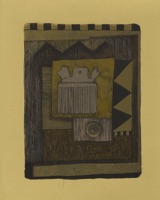
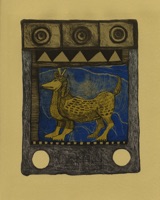
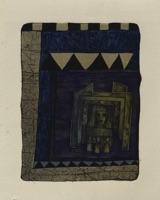
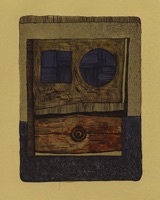
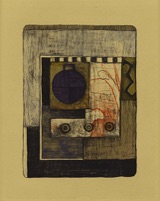
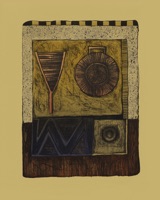
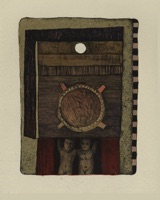
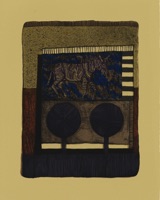
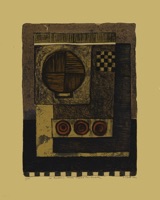
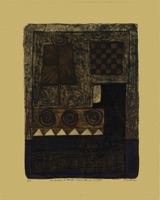
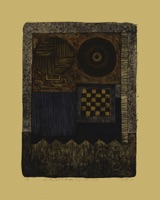
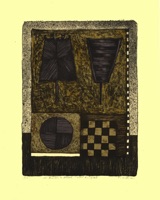
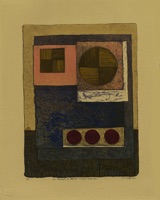
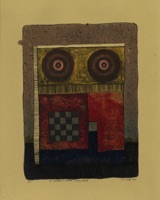
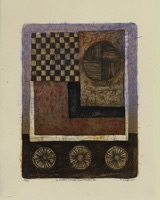
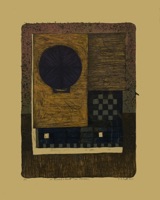
les amulets à musée:
altar ur
Lithograph 2010
320mm x 250mm
les amulets à musée:
mushhushshu dragon
Lithograph 2010
320mm x 250mm
les amulets à musée:
nimrud astarte
Lithograph 2010
320mm x 250mm
les amulets à musée:
sippar pan cube
Lithograph 2010
320mm x 250mm
les amulets à musée:
sippar pan
Lithograph 2010
320mm x 250mm
les amulets à musée:
sippar racquet pan
Lithograph 2010
320mm x 250mm
les amulets à musée:
cosimo twins
Lithograph 2010
320mm x 250mm
les amulets à musée:
lauristan
Lithograph 2010
320mm x 250mm
les amulets à musée:
sippar racquet
Lithograph 2011
320mm x 250mm
les amulets à musée:
sippar pan bull
Lithograph 2011
320mm x 250mm
les amulets à musée:
sippar banner chequer
Lithograph 2011
320mm x 250mm
les amulets à musée:
sippar pan chequer
Lithograph 2011
320mm x 250mm
les amulets à musée:
sippar cube pan
Lithograph 2011
320mm x 250mm
les amulets à musée:
sippar bulls
Lithograph 2011
320mm x 250mm
les amulets à musée:
sippar chequer pan
Lithograph 2011
320mm x 250mm
les amulets à musée:
sippar pan chequer
Lithograph 2011
320mm x 250mm